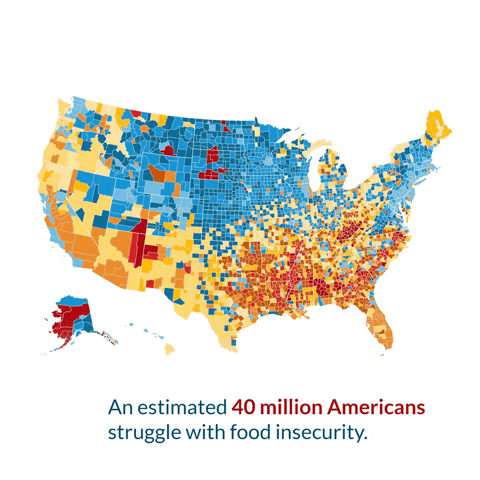- The Daily Tonic
- Posts
- A big problem is getting bigger.
A big problem is getting bigger.
Food insecurity is a serious issue in the U.S.
Wednesday. According to a recent Gallup survey, we are becoming increasingly sleep-deprived (READ THE DETAILS HERE). Today, only 42% of Americans report getting the sleep they need, and just 26% get the recommended eight hours of shuteye per night. This marks a significant decline from a decade ago. The survey suggests that rising stress levels, particularly among women, are partly to blame for this trend. Add to that the late-night hours we spend on our phones, catching up on the latest war and envying our seemingly more successful peers, and it's no wonder our sleep is suffering.
Do you know what else is suffering? The food insecurity rate in the U.S. What can we do about it? Let’s dive in.
Today’s Menu 🌿
🍽️ What can we do about food insecurity?
Are you getting enough 🧂 salt?
🍭 Your guide for quitting sugar!
The 🧄 Daily Recipe is simple, delicious, and packed with flavor.
🚫 We need limits on lead.
Read Time: 4 minutes

A Big Problem Is Getting Bigger
Food insecurity is a serious issue in the United States, affecting countless families across the nation. However, not all households feel the impacts in the same way. According to a comprehensive study by the USDA’s Economic Research Service (LINK TO STUDY HERE), there are significant disparities in food insecurity rates among different socioeconomic, racial, and ethnic groups.
The study revealed that American Indian or Alaska Native households face the highest levels of food insecurity, with rates exceeding 23%. That is more than double the national average. Among these households, nearly half experience very low food security, indicating severe problems with disrupted eating patterns and reduced food intake. This rate is almost three times higher than the general U.S. population. THREE TIMES!
Food insecurity varies greatly within other racial and ethnic groups as well. For instance, among Hispanic households, the rates range from over 11% in Cuban households to 21% in Dominican households. Asian households generally show the lowest food insecurity rates at just over 5%.
This shouldn’t come as a surprise, but income levels also play a crucial role in food insecurity, with lower-income households experiencing significantly higher rates. However, the prevalence of food insecurity among households below the poverty line varies widely among different racial and ethnic groups, from 18% to nearly 48%. This variability suggests that while income is a factor, there are other complex issues we may not be aware of.
The study used data from 2016 to 2021 to ensure a large enough sample size for accurate estimates across all groups studied. While this approach provided valuable insights, it limited the study’s ability to analyze broader economic trends or policy impacts over time. Additionally, since the data only go up to 2021, they don’t capture the recent increases in food insecurity rates that have occurred as federal aid programs implemented during the COVID-19 pandemic have expired.
During the pandemic, food insecurity rates remained stable at the national level, thanks to substantial federal support, including enhanced Supplemental Nutrition Assistance Program (SNAP) benefits and stimulus payments. Whether these policies helped in the long term is up for debate, but these measures did help prevent a spike in food insecurity during those crucial months.
It is important to note that, despite these efforts, the disparities among different racial and ethnic groups persisted and, in some cases, worsened during the pandemic.
Now, with much of the pandemic-era federal aid gone and inflation impacting costs of living, food insecurity rates are once again rising across all groups. This is a big deal, and it doesn’t look like things will get any better unless we do something. And by “we,” I mean the bright, productive minds over in D.C.—they need to do something. I won’t hold my breath.
The key takeaway? This situation underscores the importance of maintaining a robust safety net and ensuring that aid reaches those who need it most. Without a complete understanding of the disparities in food insecurity and the factors driving them, it is challenging to combat this pervasive issue effectively.
How is it that we have both a rising obesity problem and a growing food insecurity problem in the U.S.? How did the system get to this point, and what can we realistically do to fix it now? I hope someone smarter than me has the answer to some of those questions. I suspect the solution starts with combatting Big Food and Big Ag's corporate capture of our food system, but what do I know? Maybe we should start there.
Related Articles
Psst… You can reply with recommendations too!
The Daily Recipe
Try to guess… Lemon and garlic—need I say more? This recipe is a favorite of ours and is a great protein option to have on hand.
Curious? Click below to discover the recipe and see if you guessed right.
Would you try it? |
Tonic Shots
🚫 We Need Limits On Lead
FDA head calls on Congress to pass mandatory testing for lead in food. READ MORE.
🎒 Exercise Equipment You Can Use Anywhere
Getting daily movement is so important for your health. Do it anywhere with the versatile equipment from GORUCK. CHECK THEM OUT
🧂 Hydration From People That Know Something About Salt
Redmond Salt knows salt. And now they do electrolytes. CHECK THEM OUT.
"Change does not roll in on the wheels of inevitability, but comes through continuous struggle."
How was the newsletter? |
